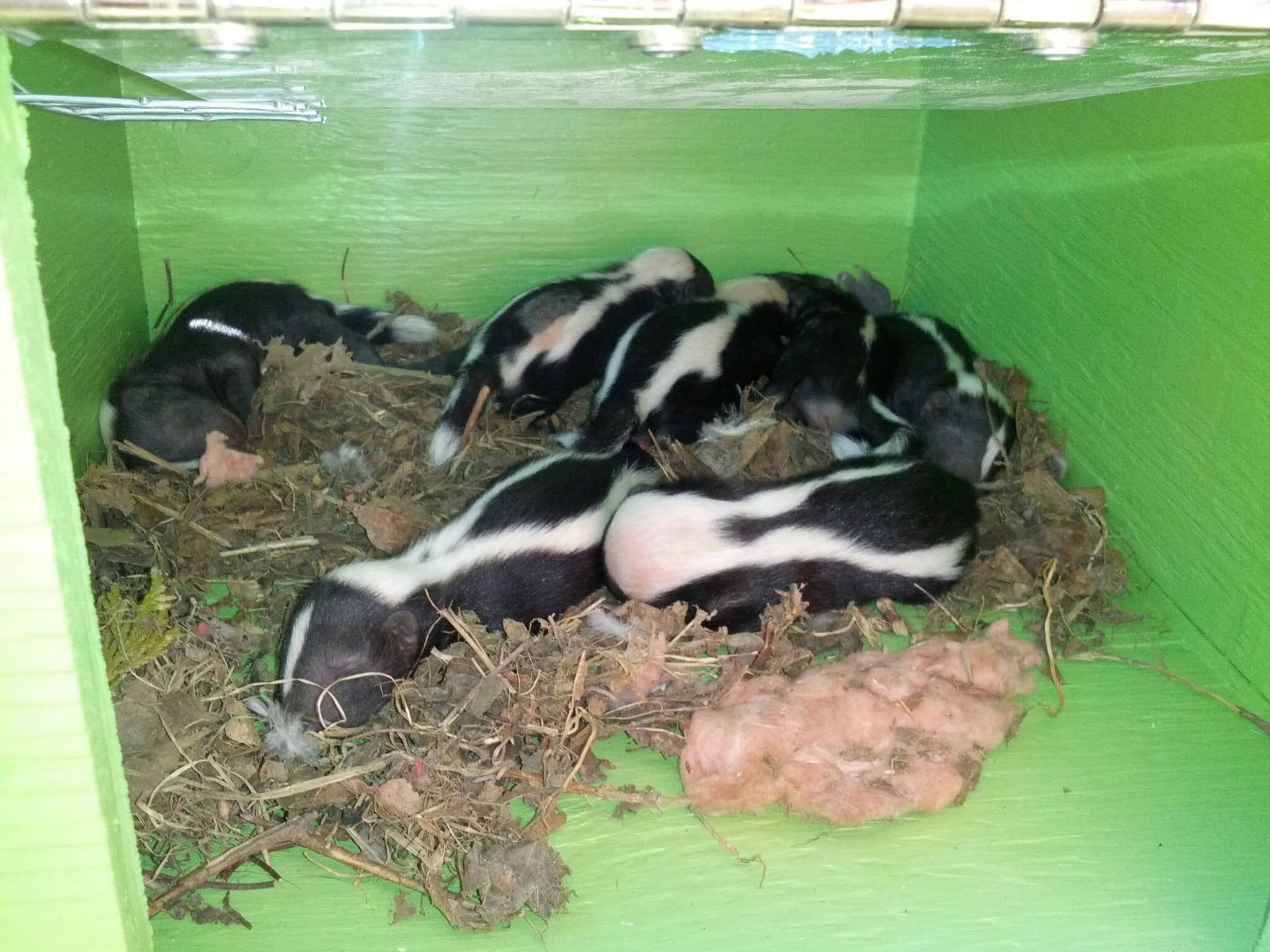SKUNK REMOVAL PROCESS
Assess and Remove
To solve a skunk problem, we start with a complete assessment of your property to determine where the skunks are living and how they’re gaining access. Since skunks do not climb our inspection will focus on the ground level den sites like porches, decks and sheds. We then perform a careful and humane removal, including any babies.
Clear and Clean
Once we humanely remove any skunks and their babies we will move on to clearing the den site of any damaged property, nesting material or debris that was gathered by the animals. We can then begin cleaning, disinfecting and deodorizing the area to eliminate any risk of illness, irritating odors and attractants for other wildlife.
Prevent and Protect
To prevent a future skunk problem, our technicians will get to work installing protective barriers designed to keep skunks out. This usually involves digging out around the perimeter of the deck, shed or porch and burying a heavy steel mesh deep into the ground. Our workmanship and materials are backed by a lifetime warranty.
Skunks are a common sight in York Region, bringing unique challenges to homeowners and businesses. These nocturnal creatures are known for their distinctive black and white fur and defensive spray, which can cause unpleasant odours and potential health concerns. As urban areas expand and human-skunk encounters become more frequent, there is an increased need for effective and humane skunk removal services. At Skedaddle, we understand the importance of addressing skunk issues in a compassionate and environmentally friendly manner. Our team is dedicated to providing innovative solutions that ensure the safety and well-being of both humans and wildlife.
Our approach to skunk removal in York Region is centered around prevention and exclusion techniques. By thoroughly assessing properties, we identify entry points and vulnerable areas that may attract skunks. We then implement measures to secure these spaces, preventing future intrusions. Our professional team prioritizes humane and effective strategies that reflect our commitment to preserving the local ecosystem. Skedaddle’s expert services are designed to minimize disruption while ensuring peace of mind for our clients. Trust us to deliver lasting solutions that protect your property and help maintain a harmonious balance with nature.
Problems Skunks Cause For Home and Business Owners
A skunk’s behaviour is primarily guided by its nocturnal nature, foraging for food during the night while seeking shelter in quiet, undisturbed areas during the day. Skunks are omnivores and often raid gardens, compost bins, and trash cans to fulfill their dietary needs, leading to messy damage around residential and commercial properties. In addition, their burrowing habits may pose significant structural concerns, as they can undermine decks, sheds, and foundations in their search for shelter.
The importance of keeping skunks away from your home extends beyond mere inconvenience. Skunks carry the risk of transmitting diseases such as rabies and canine distemper to pets and humans. Their renowned defensive spray can also cause temporary blindness and severe discomfort. In commercial settings, a skunk’s presence can tarnish a business’s reputation by emitting offensive odours and deterring potential clients or customers.
To effectively prevent skunk intrusions, homeowners and business owners can take proactive measures. Such measures include securing garbage bins with tight-fitting lids, removing potential food sources such as pet food or fruit fallen from trees, and ensuring that compost is not easily accessible. It is also beneficial to trim overgrown shrubs and bushes to eliminate potential hiding spots. Regularly inspecting the exterior of your property for possible entry points, specifically gaps in decks or sheds, and sealing them accordingly can deter skunks from nesting.
At Skedaddle, we prioritize humane wildlife removal in York Region by focusing on prevention strategies. Our expert team provides thorough inspections and implements effective exclusion techniques tailored to your property. By prioritizing these non-invasive methods, we ensure the safety and well-being of both humans and skunks, allowing for a peaceful coexistence with nature. Trust us to protect your property and maintain its wildlife harmony without resorting to harmful practices.
Skedaddle‘s Process: How To Get Rid Of Skunks
At Skedaddle, our humane skunk removal process begins with an assessment of your property. We start by carefully inspecting the area for current skunk activity, signs of entry, and potential attractants like unsecured food or shelter options. By understanding the unique dynamics of your property, we can tailor our approach to create a custom solution that addresses your specific skunk challenges.
Once we have a thorough understanding of the situation, we move on to securing the property. This step involves reinforcing weak points that could allow skunks to enter or make their home in your space. We seal gaps under decks, shed foundations, and other vulnerable areas to prevent skunks from getting inside. By creating a barrier, we effectively deter skunks and protect your property from future invasions while maintaining structural integrity.
After securing entry points, we then focus on modifying the environment to make it less appealing to skunks. This may involve advising you on proper waste management, such as using animal-proof lids on trash cans and ensuring regular removal of potential food sources like pet food or fallen fruit. Additionally, we suggest maintaining your yard by trimming back overgrown vegetation, reducing hidden areas where skunks might find shelter.
Throughout this process, we maintain our commitment to humane methods. We ensure that any skunks found during the inspection are gently encouraged to relocate themselves through natural repellent strategies, such as adjusting lighting or using sound deterrents. Our goal is to foster a harmonious relationship between humans and wildlife by encouraging skunks to seek alternative habitats naturally, without resorting to harmful practices.
Finally, we provide ongoing support and education for our clients. After the initial intervention, we stay in touch to ensure that the established preventative measures remain effective. By empowering property owners with knowledge and support, we help foster long-term solutions that ensure a peaceful cohabitation with local wildlife. At Skedaddle, we prioritize the well-being and safety of both our clients and the animals we share our spaces with, ensuring a peaceful and humane resolution to any skunk-related challenges.
Exploring York Region
York Region, a diverse and expansive area, encompasses several cities and towns north of Toronto, each offering unique experiences and opportunities. Life here combines the advantages of city amenities with the charm of more relaxed suburban and rural settings. One of the highlights of the area is Canada’s Wonderland, Ontario’s premier amusement park. Families flock to this destination to enjoy a range of thrilling rides, exciting water attractions, and entertaining shows, providing a day full of excitement.
Another annual event that showcases the unique local culture is the Markham Fair. This fall event celebrates agricultural heritage with livestock shows, a lively midway, live performances, and delicious local food, engaging community members and visitors alike in a shared appreciation of rural traditions. For those who enjoy experiencing nature, nearby Rouge National Urban Park presents a vast natural area perfect for hiking, wildlife observation, and immersive experiences with nature. This park offers a peaceful escape from the city scene and a chance to connect with Canada’s natural beauty.
Shopping enthusiasts can visit Vaughan Mills Mall. The mall provides a wide selection of retail outlets, dining options, and attractions like the LEGOLAND Discovery Centre. It serves as a shopping hub where families and individuals can spend time exploring diverse shops and entertainment under one roof.
For Skedaddle, living and working in this area means staying connected to the community while cherishing the diverse experiences that this region provides. We understand and appreciate the combination of cultural events, natural attractions, and shopping scenes that make this area special. This sense of community and variety enhances our role in supporting locals with effective, humane wildlife solutions, helping maintain the quality of life that residents hold dear.

Contact Skedaddle For Humane Wildlife Control in York Region Today
Skedaddle Humane Wildlife Control is committed to providing humane and effective solutions for managing wildlife challenges. We take pride in our approach, which not only addresses immediate concerns but also prioritizes long-term prevention. By focusing on exclusion techniques and environmental modifications, we minimize skunk-related issues while ensuring the safety and well-being of both humans and animals. Our tailored strategies reflect our understanding of York Region’s unique landscape, enhancing our ability to deliver solutions that fit seamlessly into the lives of our clients.
As advocates for wildlife harmony, Skedaddle invites you to take proactive steps toward ensuring your property remains secure and skunk-free. Whether you’re dealing with current wildlife issues or want to safeguard your home for the future, our team is ready to assist you with personalized, compassionate service. Contact us today to learn how we can help you protect your property and enjoy peace of mind, knowing that your wildlife interactions are managed with the utmost care and respect. Let Skedaddle be your trusted partner in maintaining a harmonious coexistence with nature.
Skunk Facts
FACT:
Skunks are nocturnal mammals known for their distinctive black and white stripes, which differ in each individual. These patterns serve as a warning to predators since a skunk’s spray can deter threats from several feet away.
FACT:
Equipped with exceptional defence mechanisms, skunks can release an oily, foul-smelling liquid from glands under their tails. This “skunk spray” is potent enough to cause temporary blindness if it hits a predator directly in the eyes.
FACT:
Though notorious for spraying, skunks use this as a last resort. They often give several warnings, like stomping their feet, arching their tail, or hissing, to deter threats before unleashing the malodorous defence.
FACT:
Highly adaptable creatures, skunks can thrive in various habitats, from rural fields and forests to suburban neighbourhoods. They are opportunistic omnivores, feeding on insects, rodents, fruits, and even human food waste when accessible.
FACT:
Skunks play essential roles in ecosystems by controlling insect and rodent populations. Their diet naturally reduces pests like beetles, mice, and grubs, aiding in maintaining balance within their environment while contributing to biodiversity.
CHECK OUT OUR LATEST BLOGS
York Region Wildlife Control: How Striped Skunks Adapt in the Suburbs
York Wildlife Removal: Are All Skunks Out During the Day Rabid?
York Wildlife Control: 5 Common Skunk Behaviours














